Board Games in 2023
29 Dec 2023The year 2023 was a return to big events. I attended GenCon and PAX Unplugged (as well as returning to PAX West), all as a normal attendee not trying to exhibit or pitch prototypes. As such I had time to try new games and play with friends at conventions. The following are games I played this year that warranted mentioning.
Dorfromantik: The Board Game
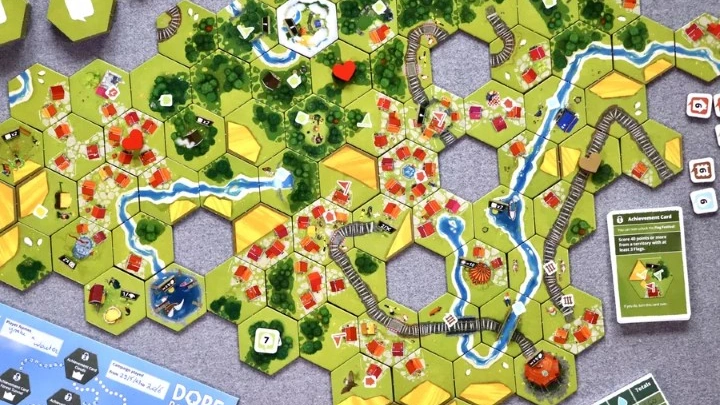 This game claimed the 2023 Spiel des Jahres (essentially the Game of the Year for board games). What if I told you there was no winning in this game? It’s a solo experience of relaxing and laying down hexes. You can play it with other people (and exclusively, I have), but mechanically the game is no different. Play a hex one at a time, try to score the most points. However, when you beat your score target, or you accomplish something quirky in the game… there are achievements. And those unlock new game components, new ways to score… and fundamentally that’s the drive that will bring you back time and time again. I’ve had a great time sitting down to a game of chill hexes with a loved one. Do recommend.
This game claimed the 2023 Spiel des Jahres (essentially the Game of the Year for board games). What if I told you there was no winning in this game? It’s a solo experience of relaxing and laying down hexes. You can play it with other people (and exclusively, I have), but mechanically the game is no different. Play a hex one at a time, try to score the most points. However, when you beat your score target, or you accomplish something quirky in the game… there are achievements. And those unlock new game components, new ways to score… and fundamentally that’s the drive that will bring you back time and time again. I’ve had a great time sitting down to a game of chill hexes with a loved one. Do recommend.
1-3 players, 30 minutes
Enchanted Plumes
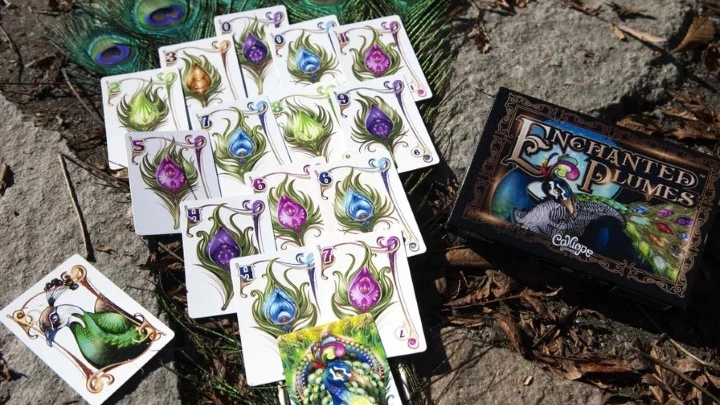 This was a delightful GenCon find. A small box of cards with numbers and colors, that’s it. You assemble these cards into a triangle of plumage, where the first (and largest row) is negative points… but every row after is positive points. But you can only use colors that appeared in the previous row. And you can only hold six cards in your hand at once. Inevitably, imperfection and compromise creep in as you race against other players. This game is elegant and portable.
This was a delightful GenCon find. A small box of cards with numbers and colors, that’s it. You assemble these cards into a triangle of plumage, where the first (and largest row) is negative points… but every row after is positive points. But you can only use colors that appeared in the previous row. And you can only hold six cards in your hand at once. Inevitably, imperfection and compromise creep in as you race against other players. This game is elegant and portable.
2-6 players, 30 minutes
Final Girl
 Quinns was pretty darn excited about Hostage Negotiator, but it sounded like a hard thing to get into. Then I heard that Final Girl is a retheme of that same concept, and it was coming to Kickstarter. Mind you, this a solo game. I’m not so sure about solo games (the main draw of the hobby is playing with friends). But we’re crawling out of the pandemic here, and I went to some weird places. So I pledged for Season 2 of Final Girl. The key to amplifying the experience of this game has been pairing it with the horror movies that inspired each box. It’s a lot more fun to play the Panic from Station 2891 box right after watching The Thing. So Final Girl has turned into a “movie and a game” date night co-op experience; watch the movie, play the movie. The game itself is tense. You’re probably going to fail. But when you succeed and smash the killer… oh yeah it feels good. Suffice to say, I’m in for Season 3’s Kickstarter too, and looking forward to more of this.
Quinns was pretty darn excited about Hostage Negotiator, but it sounded like a hard thing to get into. Then I heard that Final Girl is a retheme of that same concept, and it was coming to Kickstarter. Mind you, this a solo game. I’m not so sure about solo games (the main draw of the hobby is playing with friends). But we’re crawling out of the pandemic here, and I went to some weird places. So I pledged for Season 2 of Final Girl. The key to amplifying the experience of this game has been pairing it with the horror movies that inspired each box. It’s a lot more fun to play the Panic from Station 2891 box right after watching The Thing. So Final Girl has turned into a “movie and a game” date night co-op experience; watch the movie, play the movie. The game itself is tense. You’re probably going to fail. But when you succeed and smash the killer… oh yeah it feels good. Suffice to say, I’m in for Season 3’s Kickstarter too, and looking forward to more of this.
1-2 players, 45 minutes
Clank!: Catacombs
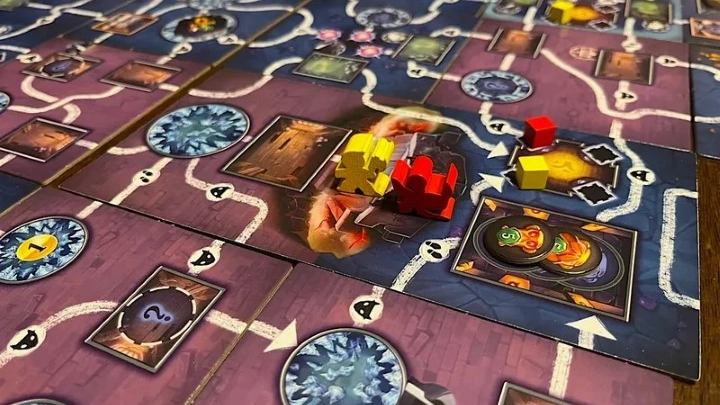 I’ve played so much Clank. The classic, every expansion board for that, the space version, the beginning of the legacy version (really need to get an opportunity to delve back into that…). Obviously I like Clank. Build a deck, don’t be too greedy, don’t be not greedy enough. This latest version, Catacombs, brings a new sense of exploration. Instead of a fixed board, you build it as you go. This means you don’t quite get the sense of place as when holding your breath underwater to get sunken treasure. But running off into the darkness is fun too. And this far into Clank’s evolution… they really have tuned the cards to be fun. I’ve had an above-average amount of fun with this particular brand of Clank.
I’ve played so much Clank. The classic, every expansion board for that, the space version, the beginning of the legacy version (really need to get an opportunity to delve back into that…). Obviously I like Clank. Build a deck, don’t be too greedy, don’t be not greedy enough. This latest version, Catacombs, brings a new sense of exploration. Instead of a fixed board, you build it as you go. This means you don’t quite get the sense of place as when holding your breath underwater to get sunken treasure. But running off into the darkness is fun too. And this far into Clank’s evolution… they really have tuned the cards to be fun. I’ve had an above-average amount of fun with this particular brand of Clank.
2-4 players, 60 minutes
Scout
 This game was so hard to get for so long (Thanks Tom Brewster :/. But it’s great. Make pairs or straights to get cards out of your hand. Empty your hand first and win. But empty your hand too aggressively and you may find yourself unable to play. It feels like a classic timeless card game, and comes in that delightful Oink box size. Portable, easy to teach, satisfying.
This game was so hard to get for so long (Thanks Tom Brewster :/. But it’s great. Make pairs or straights to get cards out of your hand. Empty your hand first and win. But empty your hand too aggressively and you may find yourself unable to play. It feels like a classic timeless card game, and comes in that delightful Oink box size. Portable, easy to teach, satisfying.
2-5 players, 15 minutes
Similo
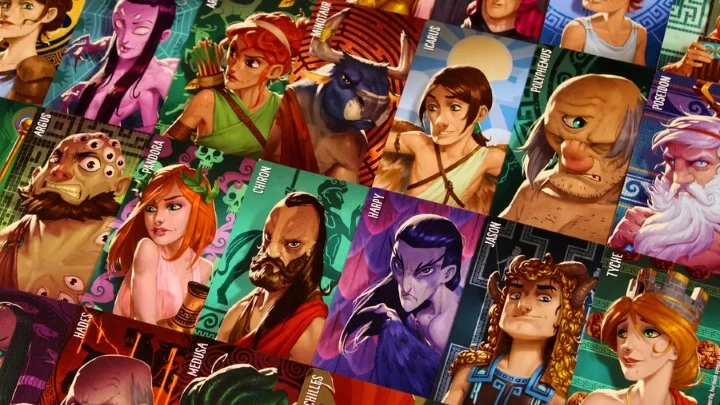 I became wise to this game via the SUSD podcast. It’s a silly thing. A deck of cards with a variety of images on a theme. Try to get people to guess one card in a grid of 16 using only other cards as a clue. Is Poseidon more similar to Athena or Artemis? Is that a comment on the art, or the lore, or… whatever whim of the clue master? Things get extra spicy when you start mixing decks (Is Hagrid similar to a chicken?). This is a great game to pack with you and bust out when you’re waiting for food at a pub. You can play exactly one round in the time it takes the ferry to get from Whidbey to Seattle. Ask me how I know.
I became wise to this game via the SUSD podcast. It’s a silly thing. A deck of cards with a variety of images on a theme. Try to get people to guess one card in a grid of 16 using only other cards as a clue. Is Poseidon more similar to Athena or Artemis? Is that a comment on the art, or the lore, or… whatever whim of the clue master? Things get extra spicy when you start mixing decks (Is Hagrid similar to a chicken?). This is a great game to pack with you and bust out when you’re waiting for food at a pub. You can play exactly one round in the time it takes the ferry to get from Whidbey to Seattle. Ask me how I know.
2+ players, 10 minutes
No Thanks!
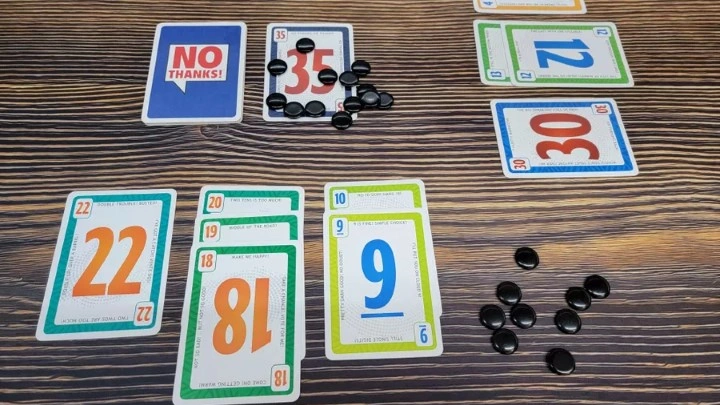 I’ve known that this game was a simple delight for a long time. But I resisted buying a copy. The Amigo production is… ugly. I contemplated making my own printing. It’s just a set of 32 cards with numbers on them. There are so many examples of alternate card designs out there. But that time spent pouting over the production was also time not playing it. So I bought an ugly copy. And I’m happy to have it in my collection. Watching players agonize over whether they should take that card (they probably shouldn’t). The hubris of thinking you’ll be able to complete a run and turn the whole thing around. Social strategy emerges from this simple game. I just wish it were a little smaller and a little easier on the eyes.
I’ve known that this game was a simple delight for a long time. But I resisted buying a copy. The Amigo production is… ugly. I contemplated making my own printing. It’s just a set of 32 cards with numbers on them. There are so many examples of alternate card designs out there. But that time spent pouting over the production was also time not playing it. So I bought an ugly copy. And I’m happy to have it in my collection. Watching players agonize over whether they should take that card (they probably shouldn’t). The hubris of thinking you’ll be able to complete a run and turn the whole thing around. Social strategy emerges from this simple game. I just wish it were a little smaller and a little easier on the eyes.
3-7 players, 20 minutes
Klask
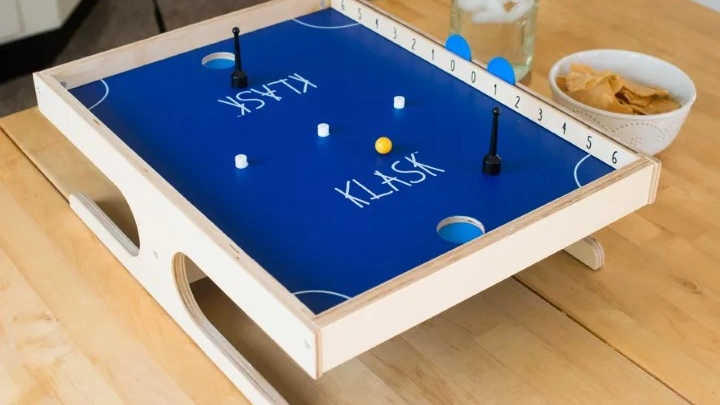 This was the year I finally got a Klask board. I’ve played Klask plenty, primarily on a yearly camping trip with friends. This year the Klask board’s owner didn’t bring it, so when later there were stacks of them for purchase at Pax West… and I finally had a home that could handle owning Crokinole and Klask… it was time for my very own. This game is electric. Your pawn is controlled by a magnet underneath the board, and you need to “kick” a ball into the opponent’s goal to score. But the special ingredient is the three “biscuits”; have two of them magnetically attach to your pawn and your opponent scores a point. Thus the game is a balance between trying to score with the ball and trying to not be so frantic that you lose to the biscuits.
This was the year I finally got a Klask board. I’ve played Klask plenty, primarily on a yearly camping trip with friends. This year the Klask board’s owner didn’t bring it, so when later there were stacks of them for purchase at Pax West… and I finally had a home that could handle owning Crokinole and Klask… it was time for my very own. This game is electric. Your pawn is controlled by a magnet underneath the board, and you need to “kick” a ball into the opponent’s goal to score. But the special ingredient is the three “biscuits”; have two of them magnetically attach to your pawn and your opponent scores a point. Thus the game is a balance between trying to score with the ball and trying to not be so frantic that you lose to the biscuits.
2 players, 10 minutes
Monikers
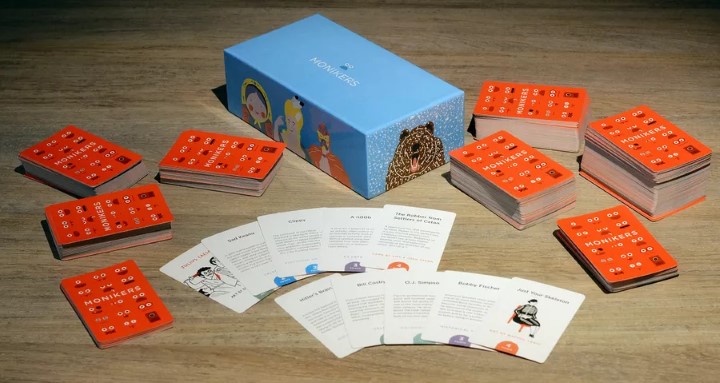 This game continues to be a favorite for large groups. If you have enough people and the right stable window of time… it’s magic. On the surface it’s just Taboo or Charades or something like that, by having three different rounds of guessing really turns into its own thing. Over those ~40 minutes you will all develop a shared secret language. And you will all laugh. Reliably. Monikers has never failed to pull off its magic trick.
This game continues to be a favorite for large groups. If you have enough people and the right stable window of time… it’s magic. On the surface it’s just Taboo or Charades or something like that, by having three different rounds of guessing really turns into its own thing. Over those ~40 minutes you will all develop a shared secret language. And you will all laugh. Reliably. Monikers has never failed to pull off its magic trick.
4-16 players, 45 minutes
Spots
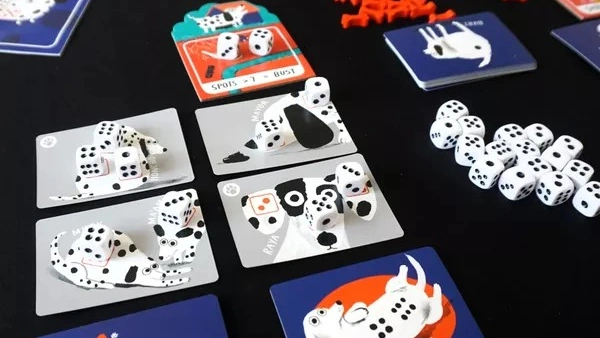 What a charming game. You roll dice, and you match the pips on the dice with the spots on dogs. Fail to match too many, and you bust. You choose different “tricks” to determine how your roll the dice. It’s simple and the presentation is stinking adorable.
What a charming game. You roll dice, and you match the pips on the dice with the spots on dogs. Fail to match too many, and you bust. You choose different “tricks” to determine how your roll the dice. It’s simple and the presentation is stinking adorable.
1-4 players, 30 minutes
Skull
 There’s nothing new about Skull for me in 2023. Well, technically they did have a new pink box release and it allowed me to refresh my copy that was visibly marked in a way that kept it from being playable with six players… but really, this game is old to me. I’ve literally played it 100 times (I keep track of these things). But once again, this was one of my top played games for the year. It’s a perfect game. Bluffing, hubris, laughter with friends.
There’s nothing new about Skull for me in 2023. Well, technically they did have a new pink box release and it allowed me to refresh my copy that was visibly marked in a way that kept it from being playable with six players… but really, this game is old to me. I’ve literally played it 100 times (I keep track of these things). But once again, this was one of my top played games for the year. It’s a perfect game. Bluffing, hubris, laughter with friends.
3-6 players, 15 minutes
Cartographers
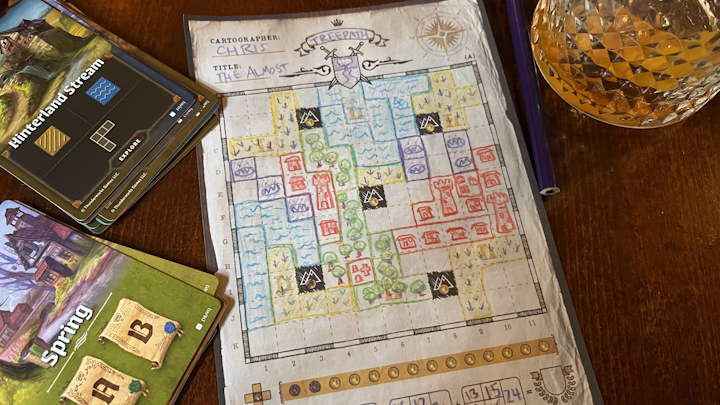 I like maps. I like drawing. I like board games. This is a board game about drawing maps. It plays simultaneously, so it scales to any player count. It’s also compact enough to be able to play at a very small table. This is a new addition to my collection, but I’m eager to play more and eager to try out the expansions.
I like maps. I like drawing. I like board games. This is a board game about drawing maps. It plays simultaneously, so it scales to any player count. It’s also compact enough to be able to play at a very small table. This is a new addition to my collection, but I’m eager to play more and eager to try out the expansions.
1+ players, 30 minutes
And the Rest
Here are some other games that are still occupying some of my brain space and are worth a little mention. Some may turn into stronger recommendations, but it’s too early to say.
Curiosities
- Dro Polter: In this game you hold a set of varied small objects in your hand (a ring, a shell, a cube, etc.). A card is flipped that shows some number of those objects, and the first person to (without looking) drop exactly those objects scores a point. Each point is bell you have to also hold in your hand… but if you drop a bell you lose it. First to five bells wins. It’s simple giggly fun.
- Rafter Five: Essentially this game is Jenga in an Oink sized box. It’s different of course, with thin cardstock planks holding wooden meeples and treasure chests. Making it more like Men at Work, actually. Regardless, it’s tense silly fun in a small box.
- Trash Talk: In this game you try to map weird dollar store items to a set of words. Does this tiny slinky map to “level” and the little racecar to “happy”, or the other way around? Each time you’re correct, add one weird little item to make the next round more challenging. It’s very much a game of getting into the head of the clue-giver.
- Lacuna: Some games are so simple that they feel like they came from an older time. Place your metal tokens to capture flowers, working towards claiming the majority in each flower suit. It’s a spatial head to head pub game… minus the fact that I wouldn’t want to lay the pretty playmat on a sticky pub table. I was persuaded by Matt Lees’ review to pick this up before playing it (a rarity for me these days), and I think it will work well as an accessible curio for a broad audience.
Let’s Color
- Sagrada Artisans: Sagrada is a game of drafting dice and filling out your stained glass window with them following certain placement rules. Artisans turns that into a coloring book legacy game. When it’s not your turn, you’re coloring your page. It completely takes the sting out of anyone’s turn running long. We’re only a few games into the campaign, but I’m really enjoying the relaxed mutual activity vibe of it.
- Blueprints of Mad King Ludwig: In the theme of “games that let you color and draw” (like Cartographers and Sagrada Artisans), this one is more complicated. Each turn your draft a new room to your growing palace, tracing it onto your piece of velum with colored pencils. The complexity is in the different per-room-type special abilities and scoring criteria. We’ll see with more plays how that holds up (and smooths out), but is undeniable that drawing a palace floorplan is fun.
Good for Kids and Adults
- Castles by the Sea: Build sandcastles with wooden blocks, populate them with your little meeples, and then watch the whole thing get knocked over by a bouncing beach ball. It’s a great theme, and a lovely rendering of that theme in 3D space. The puzzle is in playing off of existing sand blocks to efficiently score shapes. Given that mental spatial manipulation isn’t for everyone, that puzzle may short-circuit some brains. But playing it quick and casual had this one feeling good.
- Wandering Towers: Wizards are racing around a circuit getting lost in towers on their way to the constantly-moving finish line. The theme is weird. The stacking cardboard towers are great. I had more fun playing this with kids and adults than I expected.
- Penny Black: Collect stamps and add them to your collector book in patterns matching your scoring criteria. There’s nothing ground-breaking about how this game plays. But the production will leave a smile on your face. The stamp books are adorable, the tiles are clack-y, and the turn tracker is a rubber stamp. It all feels great, even if the experience is a little on the thin side.
Small Boxes
- Inheritors: In this small box card game you play ascending numbers in colored suits, and your score is the sum of the largest number in each suit. Simple, effective. But then there’s just enough interest in the cycling of cards (discards go into a center market; no number card ever leaves circulation) and some power cards to make it juicy. It has a little bit too much extra fluff, but the core is solid.
- Splendor Duel: Splendor is a modern classic. The Duel version focuses it in on two players and adds a little board to make the gem drafting more interesting. It totally works, and the result is a tuned version of the larger game.
- Radlands: Mad Max as a two player card game. Perhaps your wastelanders are bit too fragile, as the board state can be very dynamic. I’d like to spend more time with this one, more than partially influenced by the absolutely incredible art on these cards.
Main Events
- Art Society: Hang paintings on your wall, matching their frame style but not clashing their contents. Each round the paintings are allocated based on a simultaneous bid (with little paddles!). The presentation is absolutely impeccable. A gorgeous game.
- Meadow: Draft cards and play them in a natural progression, for example from mud fields to worm to bird to wolf. The art is delightful and watching your cards layer is satisfying. If I had to share a complaint it’d be that the point values are maybe too tight, where getting a 2 value instead of 3 value card just twice in the game is probably going to sink you.
- HEAT: Pedal to the Metal: I was told this was the best racing board game… and I can’t really refute that. More than anything I’ve played it captured a sense of speed and risk. Push your deck to its limits and hope that it pays out. I very much enjoyed it, and if I decide to open a slot for a racing game it may replace my critically-beloved-but-no-one-wants-to-play Flamme Rouge.
- Décorum: It’s hard to beat the provided tagline: “a game of passive aggressive cohabitation.” Work together to meet both of your shared goals for home decoration… but without communicating directly. It’s a cute little puzzle that so far lives in the space of enjoyable confusion.
Maybes
- The Hunger: You’re a vampire. Venture out into the forest, feast upon the townsfolk, and get back before sunrise. But if you feast too hard, your engorged vampire might not be able to roll itself back into bed in time. It felt like similar to Clank but with vampires. I’d give it another play.
- Wormholes: I like this game of making wormholes and making planetary deliveries. But after more plays of it it’s become clear that it has a strong runaway leader problem. If someone cracks the code, they’re going to be one or two turns ahead of you and you will never catch up. The number of moves per turn is too tight, and the game is rather short. So I guess I need to only play it with people who suck as much as I do at the puzzle?